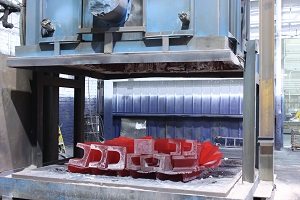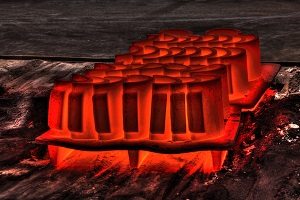Common Heat Treatments Performed At Quaker City Castings
Either for our own parts or as a contract heat treatment provider, Quaker City Castings performs the vast majority of the heat treatment necessary for ductile iron castings, steel castings, and stainless steel castings in-house. We maintain significant heat treatment capabilities and can perform heat treatment operations for a wide variety of material grades.
Applications of Heat Treatments:
Our heat treatment processes ensure that your castings achieve the desired mechanical properties and performance.
- Ductile Iron Castings: Enhancing toughness and machinability.
- Steel Castings: Improving hardness and strength.
- Stainless Steel Castings: Increasing corrosion resistance and durability.
Annealing
Annealing is a rather generalized term. Annealing consists of heating a metal to a specific temperature and then cooling at a rate that will produce a refined microstructure, either fully or partially separating the constituents. The rate of cooling is generally slow. Annealing is most often used to soften a metal for cold working, to improve machinability, or to enhance properties like electrical conductivity.
Benefits of Annealing
This process offers multiple advantages depending on the material and desired outcome.
- Softening: Makes metals easier to work with.
- Improved Machinability: Easier to machine and shape.
- Enhanced Properties: Improves electrical conductivity and other characteristics.
Normalizing
Normalizing is a heat treatment technique used to provide uniformity in grain size and composition throughout an alloy. The term is often used for ferrous alloys that have been austenitized and then cooled in open air. Normalizing not only produces pearlite but also martensite and sometimes bainite, which gives harder and stronger steel, but with less ductility for the same composition than full annealing.
Advantages of Normalizing
This treatment provides several benefits for alloy uniformity and strength.
- Uniform Grain Size: Ensures consistency throughout the alloy.
- Enhanced Strength: Produces harder and stronger steel.
- Versatility: Suitable for various ferrous alloys.
Stress Relieving
Stress relieving is a technique to remove or reduce the internal stresses created in a metal. These stresses may be caused in a number of ways, ranging from cold working to non-uniform cooling. Stress relieving is usually accomplished by heating a metal below the lower critical temperature and then cooling uniformly.
Benefits of Stress Relieving
This process helps in maintaining structural integrity and reducing potential issues.
- Reduces Internal Stresses: Minimizes the risk of deformation and cracking.
- Improves Stability: Enhances the dimensional stability of components.
- Enhanced Durability: Increases the lifespan of the treated parts.
Aging
Some metals are classified as precipitation hardening metals. When a precipitation hardening alloy is quenched after heat treatment, its alloying elements will be trapped in solution, resulting in a soft metal. Aging a “solutionized” metal will allow the alloying elements to diffuse through the microstructure and form intermetallic particles. These intermetallic particles will nucleate and fall out of solution and act as a reinforcing phase, thereby increasing the strength of the alloy.
Applications of Aging
This process is essential for enhancing the properties of certain alloys.
- Strength Improvement: Increases the strength of precipitation hardening metals.
- Controlled Hardening: Allows for the precise adjustment of hardness levels.
- Wide Range of Metals: Applicable to aluminum alloys, superalloys, and stainless steels.
Quenching
Quenching is a process of cooling a metal at a rapid rate immediately after heat treatment. This is most often done to produce a martensite transformation. In ferrous alloys, this will often produce a harder metal, while non-ferrous alloys will usually become softer than normal.
Benefits of Quenching:
This technique is crucial for achieving desired hardness and mechanical properties.
- Increased Hardness: Produces a harder and more wear-resistant surface.
- Rapid Cooling: Essential for achieving specific microstructures.
- Versatile: Can be used with various cooling media like air, oil, water, or brine.
Tempering
Untempered martensitic steel, while very hard, is too brittle to be useful for most applications. A method for alleviating this problem is a heat treatment called tempering. Most applications require that quenched parts be tempered. Tempering consists of heating steel below the lower critical temperature, (often from 400 to 1105 ˚F or 205 to 595 ˚C, depending on the desired results), to impart some toughness.
Advantages of Tempering
This process balances hardness and toughness to create durable components.
- Reduces Brittleness: Makes martensitic steel more usable.
- Improves Toughness: Increases the material’s ability to absorb energy.
- Customizable: Different tempering temperatures can yield various properties.
Work With Us
If you’re looking for a reliable partner for your heat treatment needs, Quaker City Castings is here to help. Visit our contact us page directly to discuss how we can assist you. We are dedicated to providing solutions that enhance the efficiency and productivity of your operations.



